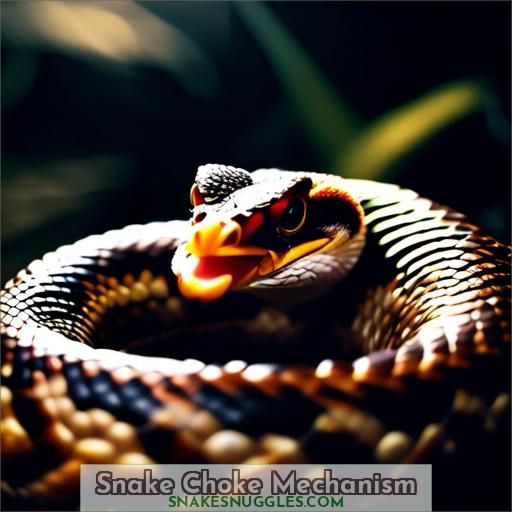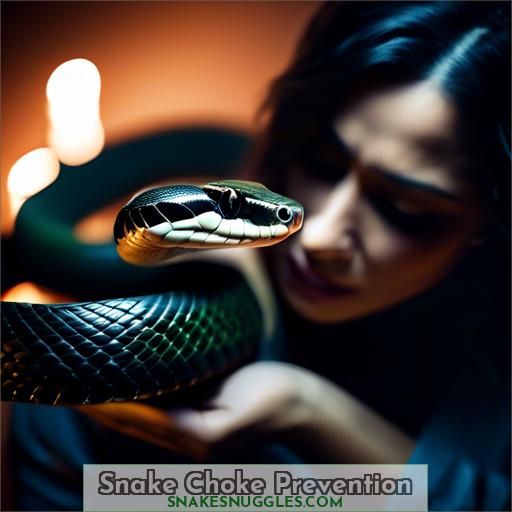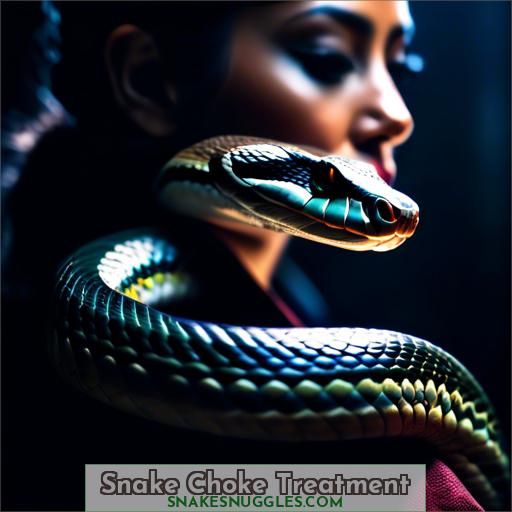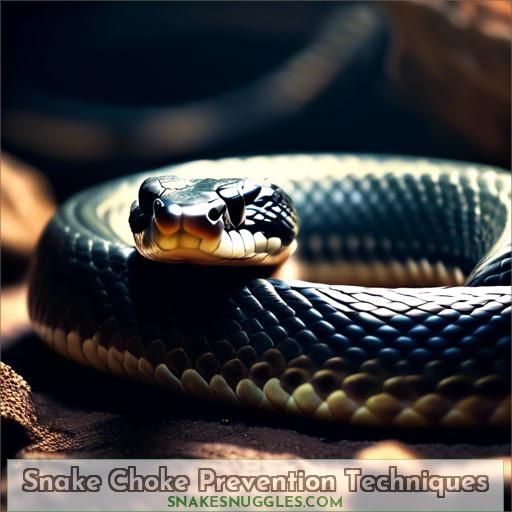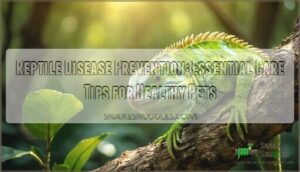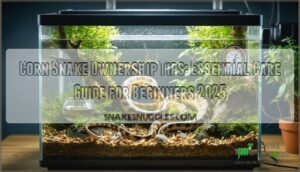This site is supported by our readers. We may earn a commission, at no cost to you, if you purchase through links.
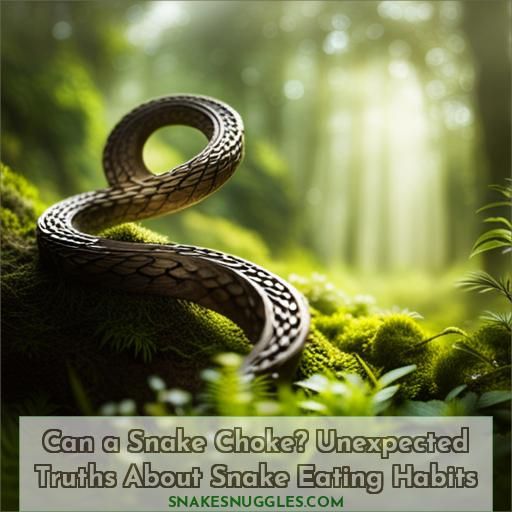
You might be surprised to learn that snakes don’t choke in the same way humans do. They swallow prey whole, and their jaws expand to accommodate the prey. However, snakes can experience obstructions in their mouths or airways, which can lead to complications.
To prevent such occurrences, it’s essential to comprehend the snake’s swallowing mechanism and use appropriate handling methods. This includes using gloves and tools for snake handling, providing suitable habitat and proper care, and seeking veterinary attention for snake health.
By understanding these facts, you can guarantee the well-being of your snake and prevent potential choking hazards.
Table Of Contents
Key Takeaways
- Snakes don’t choke in the same way humans do. They swallow prey whole and have a specialized mechanism to do so, which includes expanding their jaws and using reflexive actions to move the prey down their esophagus.
- There are risks associated with this process, such as regurgitation or vomiting, which can be signs of problems with the snake’s digestive system or husbandry.
- To prevent regurgitation and vomiting, it’s essential to follow guidelines like not handling snakes for 48 hours after a meal, not feeding immediately after transport, providing appropriate habitat and care, and feeding appropriately sized prey.
- If a snake is vomiting or regurgitating, it’s important to seek veterinary attention, as these symptoms can indicate serious problems like intestinal parasite infections, bacterial infections, or intestinal obstructions.
Can a Snake Choke the Truth May Surprise You?
Yes, a snake can choke. Snakes, particularly those that consume large prey, can have difficulty swallowing and may regurgitate their food, which can lead to suffocation if the food isn’t removed.
However, snakes have evolved a way to keep themselves from suffocating while they constrict and swallow their prey. They can change how they breathe so that they use ribs and muscles farther down the length of their body, allowing them to continue breathing while squeezing and swallowing their prey.
Snake Choke Mechanism
Snakes are fascinating creatures, but they aren’t known for their ability to choke. Snakes swallow their prey whole, and they’ve a specialized mechanism to do so. When they eat, they expand their jaws to accommodate the prey, and the prey is then moved down the snake’s esophagus. This process is known as swallowing, and it’s a reflexive action that allows snakes to consume their food without the need for chewing or grinding.
However, there are some risks associated with this process. For example, if a snake eats something that’s too large for it to swallow, it may regurgitate the food. This can be a sign of a problem with the snake’s digestive system, and it may require veterinary attention. Additionally, if a snake isn’t given enough time to digest its food, it may vomit, which can be distressing for the snake and may indicate a problem with its husbandry.
To prevent regurgitation and vomiting, it’s important to follow some basic guidelines. For example, snakes shouldn’t be handled for 48 hours after a meal, and they shouldn’t be fed immediately after transport. Additionally, the temperature of the snake’s enclosure should be appropriate for digestion, and the snake should be fed appropriately sized prey. This means that the prey shouldn’t be larger in diameter than the snake’s head, and the frequency of feeding should be based on the size and age of the snake.
If a snake is vomiting or regurgitating, it’s important to seek veterinary attention. This can be a sign of a serious problem, such as an intestinal parasite infection, bacterial infection, or intestinal obstruction. In some cases, a colonic wash may be necessary to obtain an adequate fecal sample for diagnostic testing. Treatment may involve addressing the underlying cause of the vomiting or regurgitation, such as a dietary issue or a husbandry problem.
Snake Choke Prevention
Snake chokes are a common concern for those with Obsessive-Compulsive Disorder (OCD). To prevent snake chokes, it’s imperative to comprehend the signs and symptoms. Individuals with OCD don’t desire to harm others. They’re often distressed by these thoughts and may engage in compulsions to prevent harm.
To overcome OCD, consider using techniques such as Exposure and Response Prevention (ERP) or reading books like The OCD Workbook. If a family member has OCD, it’s vital to provide support and understanding. Encourage them to seek professional help and practice empathy and patience.
By being aware of these facts and taking preventative measures, you can reduce the likelihood of experiencing snake chokes and improve your overall well-being.
Snake Choke Treatment
After understanding how to prevent a snake from choking, it’s imperative to recognize the treatment steps if an incident occurs. When confronted with snake choke symptoms, swift action can lead to recovery. Here’s a concise guide on snake choke first aid:
| Action | Purpose |
|---|---|
| Inspect mouth | Identify obstructions causing choke symptoms |
| Remove substrate | Clear airway to facilitate breathing |
| Consult veterinary professional | Secure professional attention for recovery |
Snake Choke Prevention Techniques
Regarding snake choke prevention, the wisest course of action is to be preemptive. This includes:
Investing in choke management skills, such as appropriate handling and restraint methods. This involves using gloves and tools tailored for snake handling.
Undergoing first aid training to learn how to identify and respond to snake bites.
Safeguarding animal welfare by providing your snake with a suitable habitat and proper care.
Considering seeking veterinary care for your snake to assure its health and well-being.
If you’re struggling with malevolence OCD, bear in mind that seeking reassurance and checking aren’t effective coping mechanisms. Instead, pursue treatment through exposure and response prevention (ERP) therapy.
By adhering to these steps, you can minimize the probability of a snake choke and ensure the safety of both you and your snake.
Conclusion
Wrapping things up, the idea that a snake can choke might catch you off guard, but it’s a real concern for these reptiles. Armed with knowledge about their unique swallowing mechanism, you’re now better equipped to prevent and address any potential obstructions.

